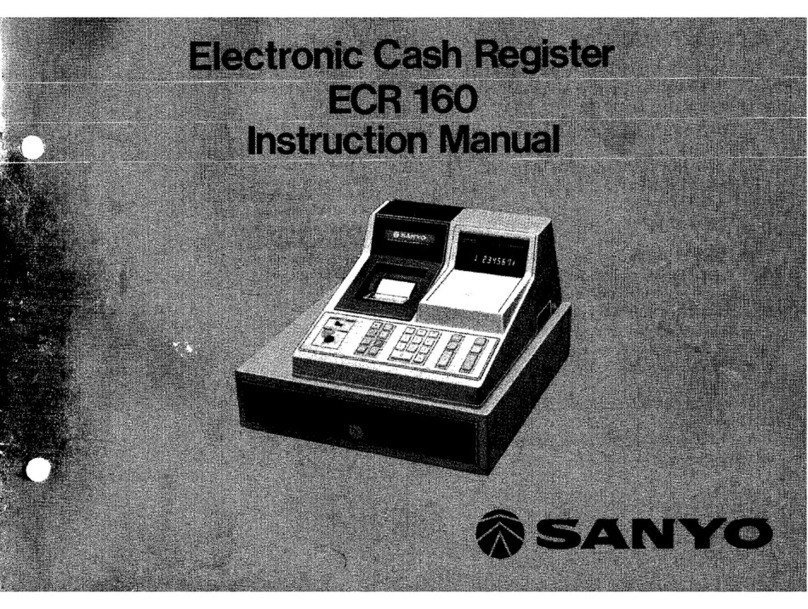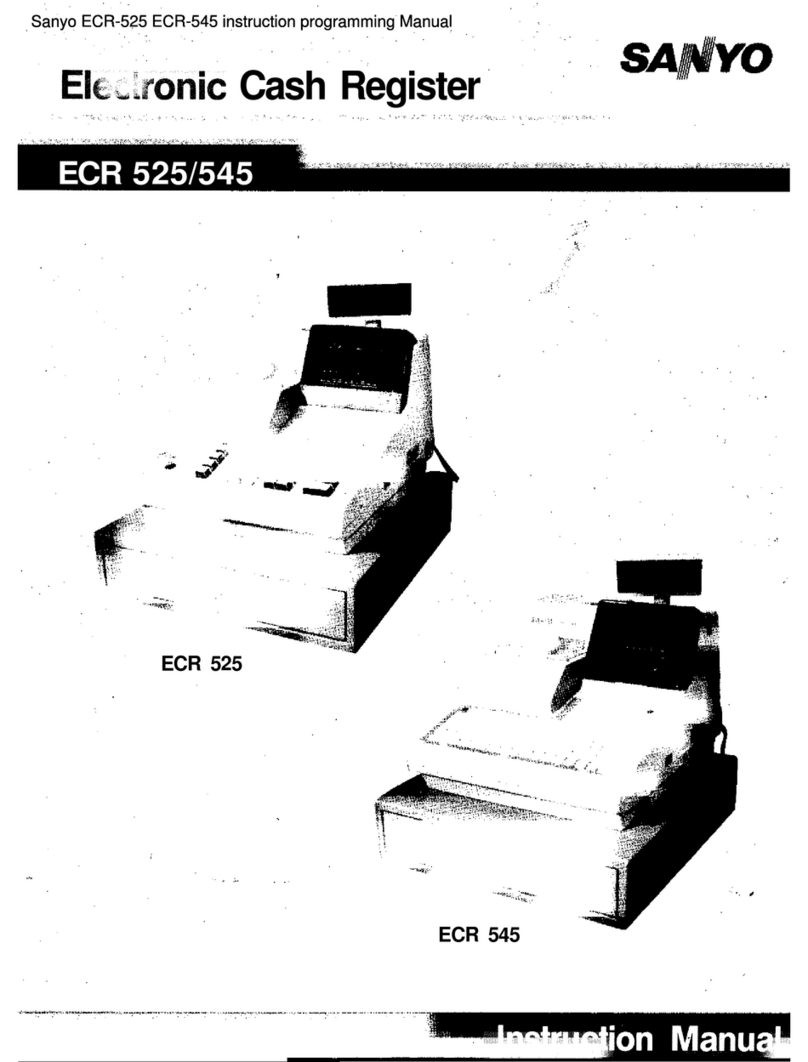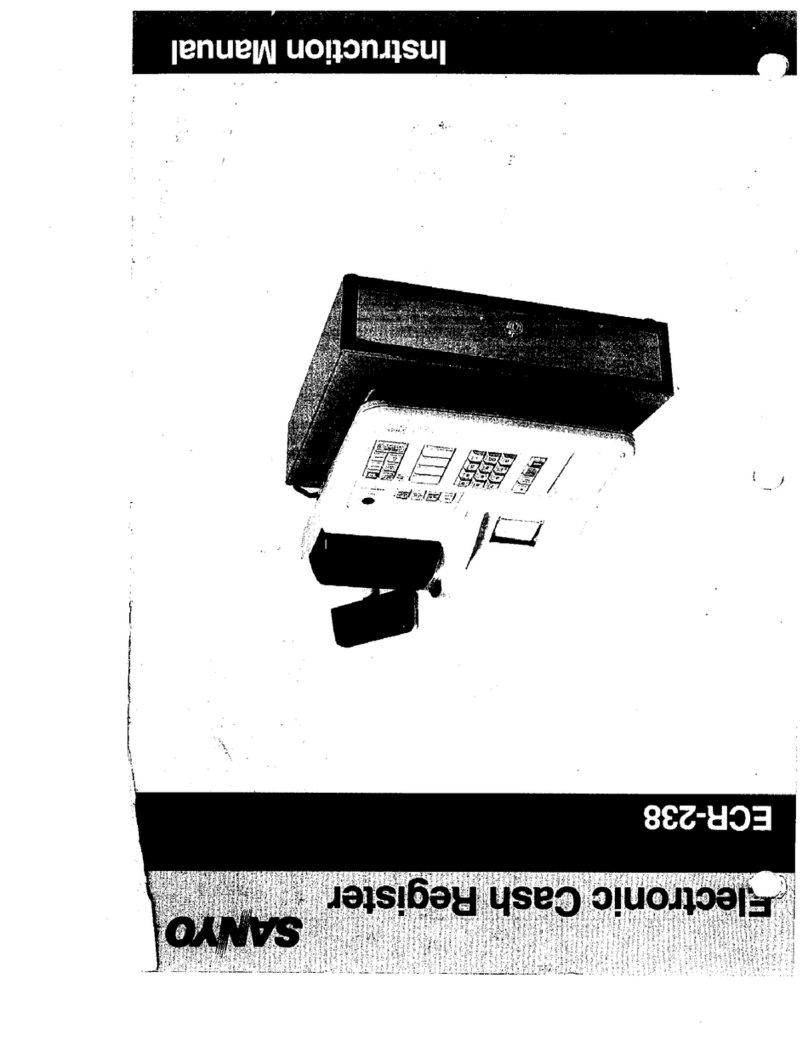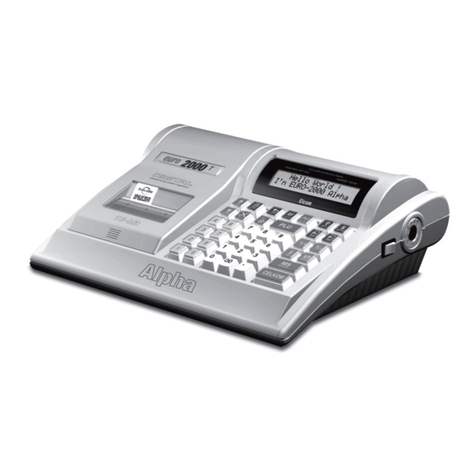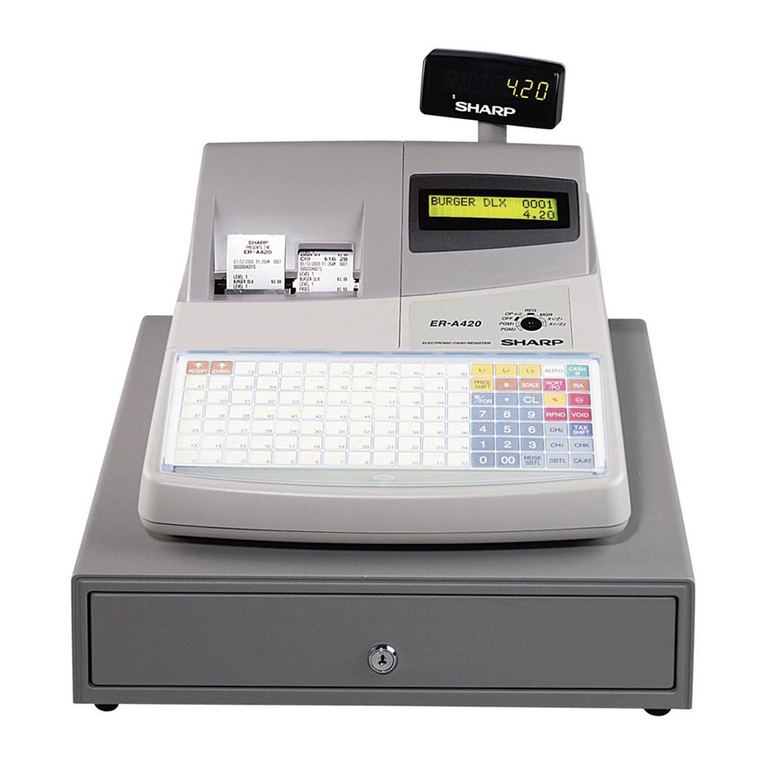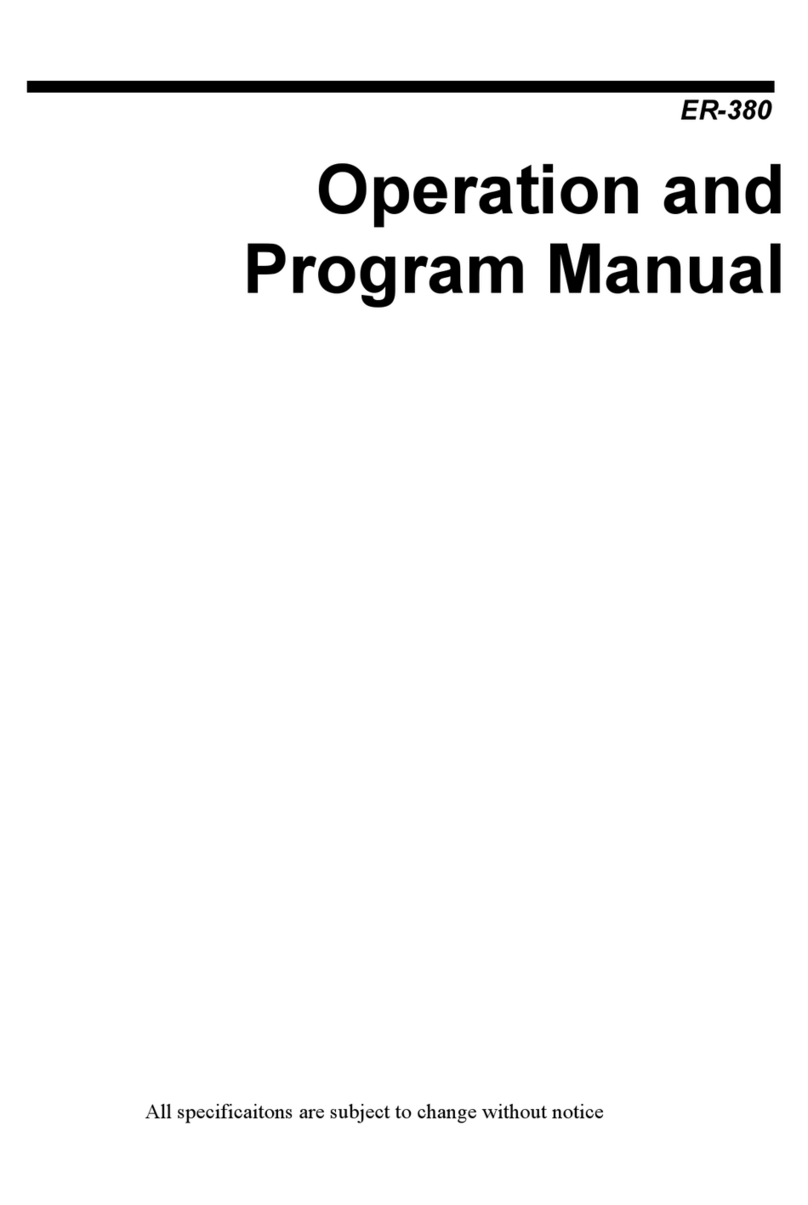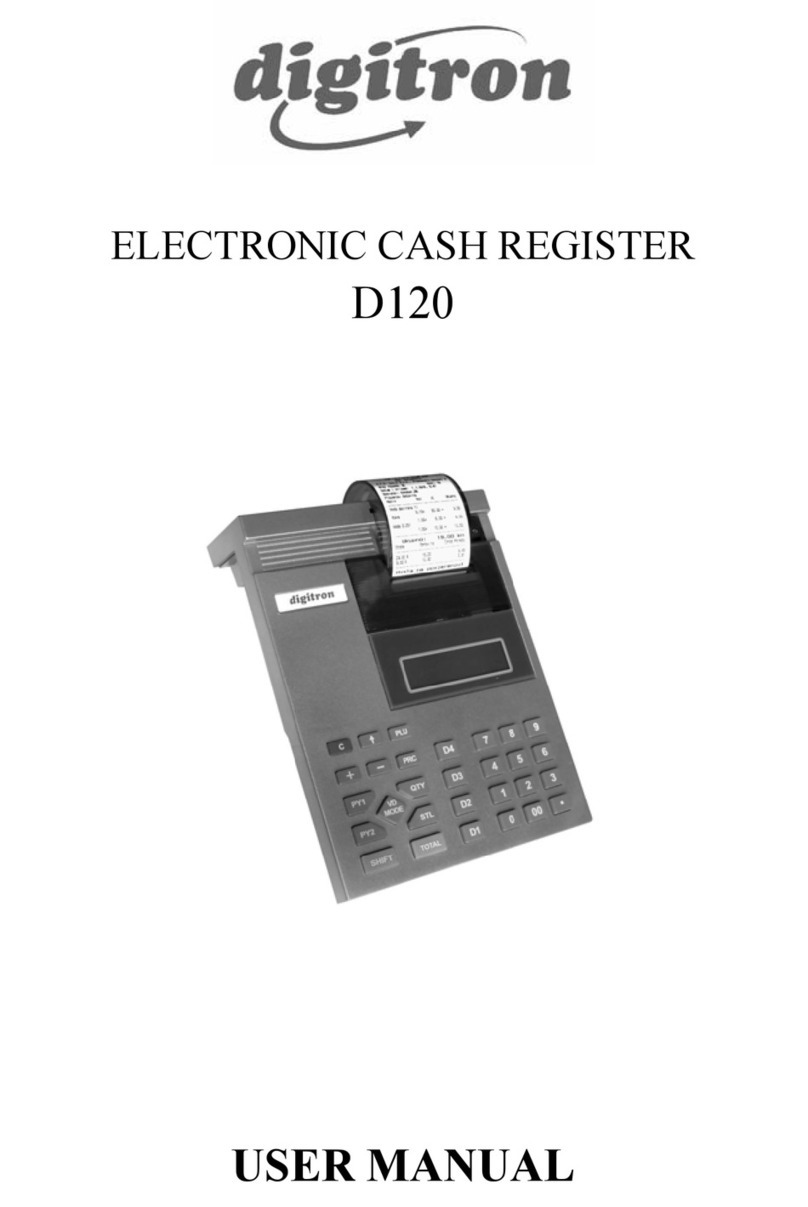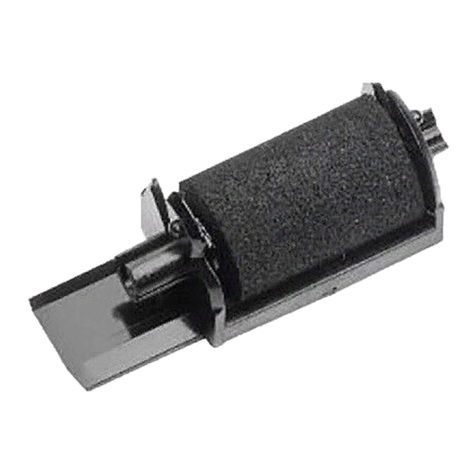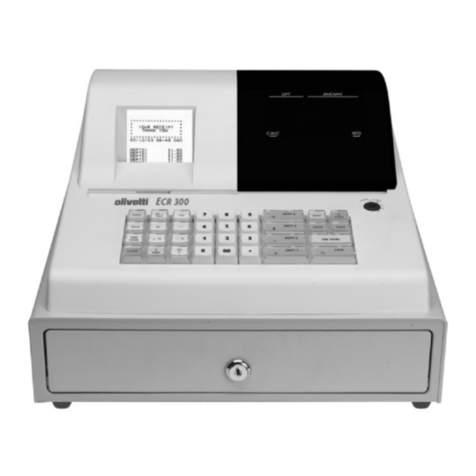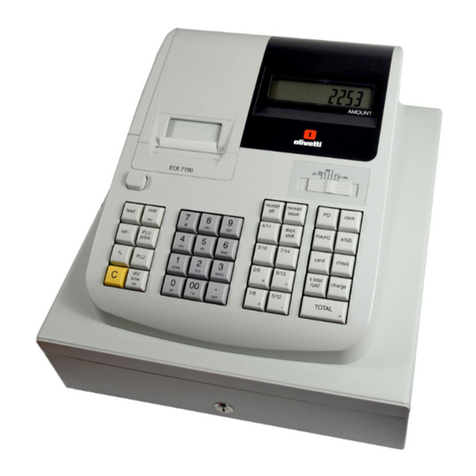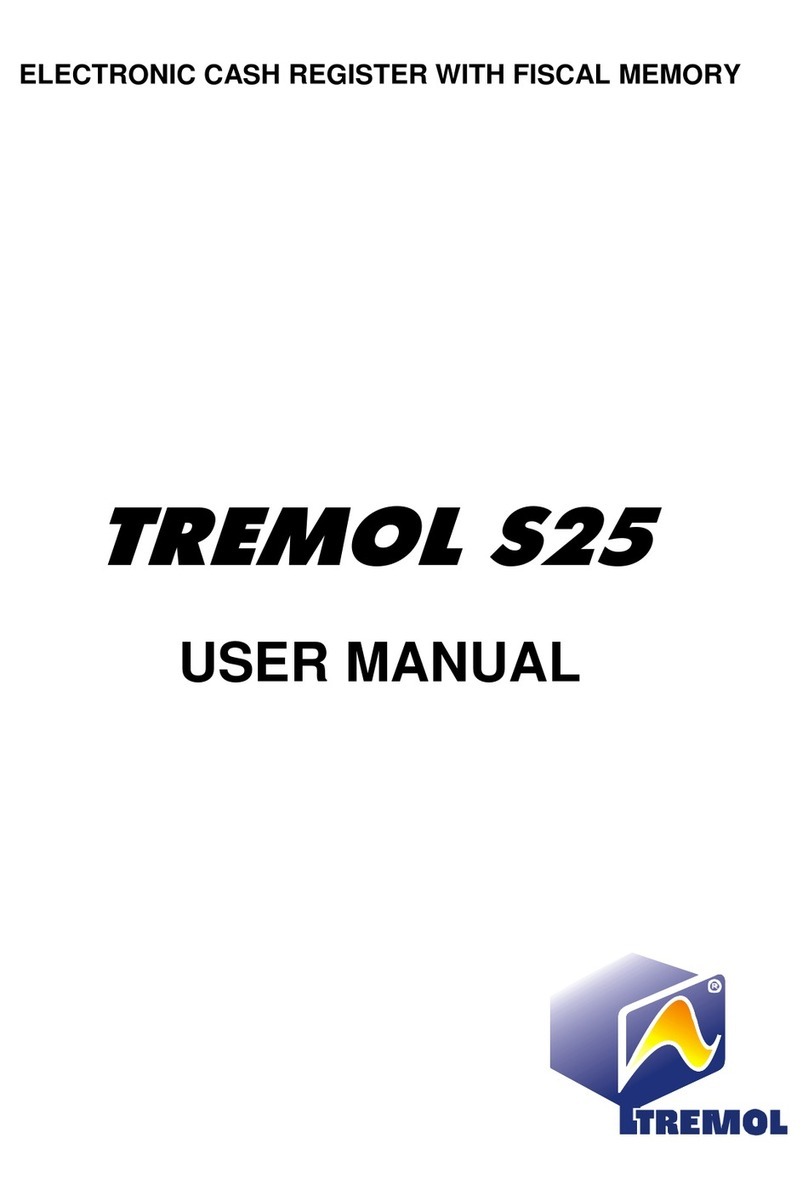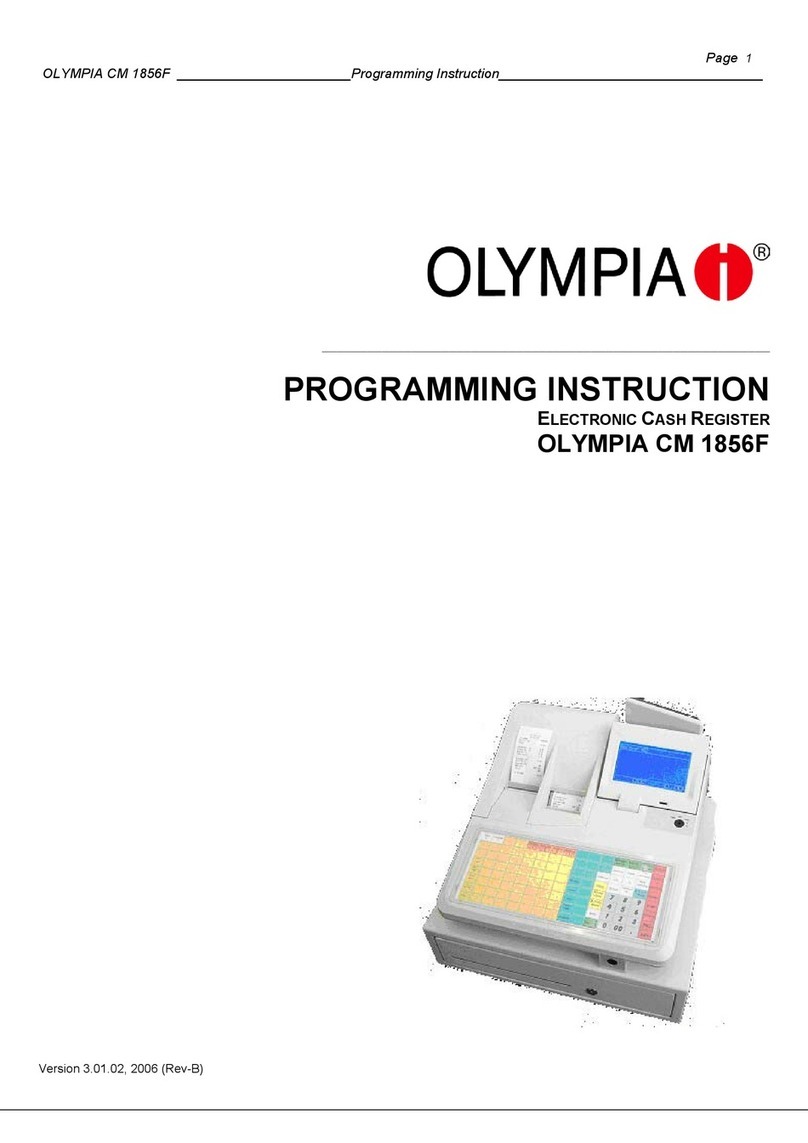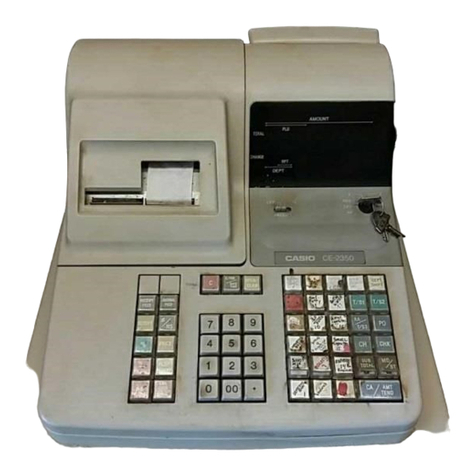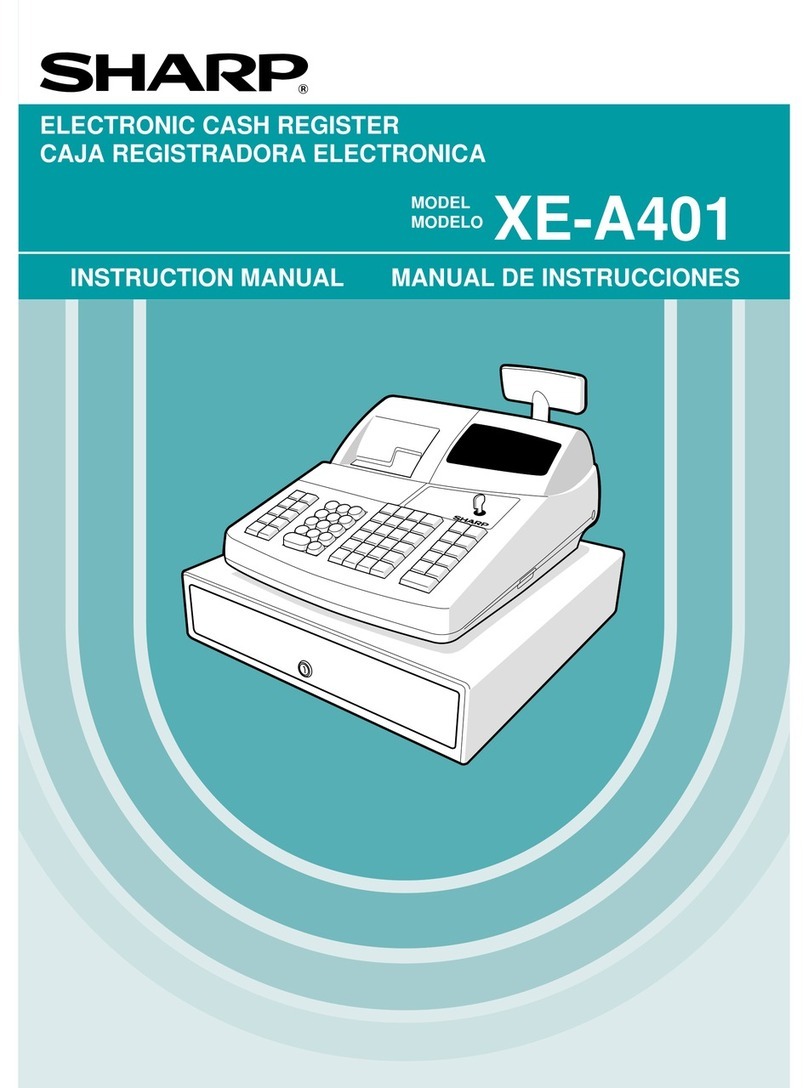Sanyo ECR105 User manual

065.005.
1
067.673.4
SANYO
nn
QUEL
-
07170
SERVICE
MANUAL
ECR105/115
ELECTRONIC
CASH
REGISTER
ECR105
ECR115
SPECIFICATIONS
Number
of
Departments:
2
Number
of
totals:
9
Battery:
Rechargeable
Ni-Cd
Uatteries
for
memory
protection
Memory
holding
time:
Approx.
1.000
hours
without
Power
supply
from
AC
Printer:
Digital
wheel
type
serial
printer
14-digits
for
numeric
and
1
digit
for
symbol
Indicator:
Green
fluorescent
multi
digits
display
tube
1
digit
for
symbol
+
1
digit
for
repeat
counter
+
7-digits
for
amount
Up
to
7
digits:
Ten
key
system
Multiplication:
Quantity
&
4-digits
Price
&
5-digits
Result
&
7-digits
Number
print
Ps
8-digits
Number
of
figures
for
input:
Number
of
figures for
total:
Non-resettable
GT:
12-digits
Other
amount
total:
8-digits
Counters:
4-digits
Roll
paper:
57.5mm
x
Max.
80
(¢)
mm
Inking:
Ink
roll
R-S874274
(Purple)
Operation
temperature:
Power
supply:
Power
consumption:
Dimension:
Weight:
0~
40°C
(32
~
104°F)
AC
Local!
Voltage
+
10%,
50/60
Hz
Max,
6W
318(W)
x
408(D)
x
242(H)
mm
(ECR105)
405(W)
x
423(D)
x
250(H)
mm
(ECR115)
Net
5.8Kg
(ECR105)
Net
8.0Kg
(ECR115)

INDEX
:
Page
CABLE
CONNECTION
DIAGRAM
.........0.0.0
0002
eee
ee
1
SCHEMATIC
DIAG
RAM
vic
iee5
2-5
hs
ise
aa
RO
eed
oS
Se
dee,
Stee
a
eds
ews
eo
ee
ee
ee
2,3
P.C.-BOARD'
DIAGRAM
(s.c%e-e5-2
OS
dee
eS
oe
eee
Med
Da
Sele
a,
SSE
ee
Bohl
TE
GRAS
ee
4,5
BLOCK.DIAGRAM
©
22s:
oh
eo
ed
AY
eS
eee
eed
one
ee
ae
eee
AO
te
a
eal
ale
6
OPENING
THE.UNIT
25
co-23
4.
che
OE
ie
Oe
le
eee
ae
lochs
AG
esis
w
bee
ee
me
6,7
REASSEMBEING
soo
senescence.
bce
hanes
ol
cutee
Rats
hd
Aaa
Ee
ele,
Wet
IS
eae
Ag
Steed”
Eg
Sree
7
SETTING
OPTIONAL
SELECTIONS...
0.2.0.0.
2
ete
ee
te
eee
7,8
DEVICE
SPECIFICATIONS
....
20.0.0...
cc
ee
ee
ee
ete
eens
8-10
DESCRIPTION
OF
CIRCUITS
..
0.0.0.0...
2
ee
eet
eens
11-13
PRINTER:
2:
ooo
kd
8
eo
eee
Ba
ee
Et
SE
8
a
ec
eter,
yea
Ph
De
SE
14
—
24
EXPLODED:
VIEW
sos
selete
aie
ot
Ea
ee
Lee
eae
ee
Ba
Sete
ee
ls
chat
Swe
Bete
he
wie
eee
25
PARTS
EIST
vs,
sense
setters
3d)
Berean
acs
ee
Ste
act
aealles
Bod
ee
Ree
EN
ene
ae
paar
ae
eS,
ay
eA
gee
ge WE
ath
26
—
28
ORAWER
EXPLODED
VIEW/PARTS
LIST
........
0.00
ce
ee
ee
ee
eet
eee
eee
“2...
29,
30
PRINTER
MECHANISM
EXPLODED
VIEW/PARTS
LIST
..
0.0...
0...
eee
ee
eee
31
CABLE
CONNECTION
DIAGRAM
POWER
PCB
fa
__)
cs4
4
i
|
|
|
V7
LILEILLLILLILIZILLILG.
M2
12>
AC
t
t
I
L.
4
vA
y
ECR
115
only
Gas
(ere
|
Ree
pecs
ee
1
cs
(||
Zs
|
|
|
PRINTER
ECR
115
only
M1
(MAIN)
PCB
>

SCHEMATIC
DIAGRAM
ae
ee
ee
eae
eae
we
a a
eae
ee
ener
rere
FG98B7
REAR
DISPLAY
vec
SdSOpSc
Sb
Se
VF
|
|
|
|
Se
G
G2
G2
Gt
st
3.3
32g
Fe
eee
!
ff]
J
(ese
cs?|
=
cps
C@DAOOOOOONOOD
COOROONOaD]
<P?
|
4
Sang
cpee
pep
se
emer
EEEEEEEEREES=
FRONT
DISPLAY
FG98B8I
prawer
623
£P3
ame
we
VF
_SOpSgSt
Se
$4
Sc
Sd
So
@9
G8
67
06
05
G4GI
CGI.
6)
cs
BK
as
fa
Gi
sf
©
BORERO
ES
Pet
eehees
PC
470/10
Wired
:
iH
R40
Oo
O5ea2
5.6
sw
040
>
05442
as7
«
|
Prater
csioi
csi
“42-5

P.C.
BOARD
DIAGRAM
(
)
bracket
diode
is
for
ECRII5
only,
((
))
bracket
diode
is
for
ECR
105
only,
.
.
NOTE
M1
P.C.B
re
:
C.B
M2
P
g'O'd
LI
gore
2a,
i
i
OI
OAS
|
mereseenaifiess
SOR
pap
peg
eS
0
ae

BLOCK
DIAGRAM
1c2
KEY
MATRIX
MODE
MATRIX
KEY
RETURN
SIGNAL
MODE
RETURN
SIGNAL
RES
X2
XT1
XT2
x1
OPENING
THE
UNIT
1,
Disassembling.
(1)
Disconnect
AC
cord.
(2)
Detach
the
printer
cover.
(3)
Push
and
lift
the
loweredge
of
cabinet
(A).
Fig.
1
2.
Removing
the
printer.
(1)
Disconnect
the
flat
cable
(B))
and
earth
line
(©).
TP
tP
PRINTER
M-4211
Pew
—o]
ORE
1C3
DRIVER
1c4
ORIVER
Qi
DRAWER
BUZZER
POWER
DOWN
DETECTION
CIRCUIT
1C1,
QZ
RESET
CIRCUIT
1C1,
Q2
Fig.
2

(2)
Pull
the
hook
((O))
and
lift
the
printer.
(3)
Removing
the
printer
from
cabinet.
Wiis
Printer
Unit
3.
Removing
the
main
PCB.
Fig.
4
(1)
Turn
off
the
battery
switch
located
beside
the
Nicd
battery.
(2)
Disconnect
the
connector
of
power,
printer
and
etc.
(3)
Removintg
4
screws
fastening
the
main
PCB
and
metal.
(4)
Push
2
hooks
©)
and
take
out
the
metal.
(5)
Removing
the
main
PCB
from
cabinet.
REASSEMBLING
(1)
Avoid
misconnection
between
connector
and
terminal
of
PCB,
confirm
the
connection
is
correct
and
tight
it.
(2)
Plug
in
AC
cord
at
first,
then
turn
on
the
battery
switch,
CLEAR
THE
NON-
RESETTABLE
TOTAL
AND
Z-COUNTER
It
is
possible
to
clear
the
Non-reset-
able
total
and
Z-counter
by
the
following
key
operation.
(P
Mode)
(1)
(90)
O
(5)
(2)
(3)
CASH]
This
operation
will
clear
all
totals
maintained
in
the
memory
to
zero
(except
the
date
and
time),
and
printout
all
characters.
(Fig.
A)
(olejelslejeleleleleleleleien:
4
T111777171319104
22222222222222K2
33333323333333M3
GO444444444444T4
5555555555555590
66666E66666666
N+
TITITTTITITTITI
To
BESSESSBSEBESBNX
e99999990900S999fa
rIxx99x9x99999
KS
wore
recesesoeree
XK
SETTING
OPTIONAL
SELECTIONS
(1)
Shift
of
decimal
point
The
number
of
digits
after
the
decimal
point
can
be
selected
out
of
DP
=
0,
1,
2
and
3
by
diodes
at
the
location
marked
DPO,
DP1,
DP2
and
DP3.
(Fig.
6)
DPO, DP1,
DP2
and
DP3.
(Fig.
6)
(D26)(D21)(018)
(D13)
(2)
5
Rappen
rounding
(for
Swiss
market)
The
least
significant
digit
of
the
result
of
%
or
tax
calculation
will
be
rounded
to
0
or
5
as
follows:
Normal
calculation
:
Round
to
O~2
:
0
3~7
:
5
8~9
:
10
(3)
Department
(M115
:
D24),
Paper
feed
(PF
:
D22)
These
diodes
should
be
always
mounted.
ed
om
Psess
ord
&
eS
on
SS
aceen:
L
\_
aCuruMm
ema
us
acento
2.
14
ic

(4)
%
Mode,
Tax
Mode,
Japan
Mode
Absolute
Maximum
Ratings
(Ta
=
25°C)
These
mode
can
be
selected
by
diodes
at
the
location
marked
EUR
(D23)
and
DOM
(D716).
(Fig.
6)
The
combinations
are
shown
in
the
following
table.
Power
Supply
Voltage
Input
Voltage
Operation
Temperature
reea
{x
[eI
ree
ee
©
:
Add
the
diode.
X
:
Do
not
add
the
diode.
Storage
Temperature
$390
Besides
the
above
selection
it
is
necessary
to
change
S20
rubber
key.
Slo
soo
(5)
Don’t
use
diodes
at
the
location
marked
D14,
D17
POO/INT4
O
(CV)
and
D25
(45P).
(Fig.
6)
Po1/SCK
O
(6)
Mode
switch
selections
po2z/S0
0
ECR
105:
Add
the
diodes
marked
D4
(PS),
D6
(R),
D7
ae
(Z)
and
D8
(X).
(Fig.
6)
PIV/INTIO
ECR
115:
Add
the
diodes
marked
D12
(PS),
D19
{Z),
PIZ/INT2Z
O
D20(X),
027(R).
(Fig.
6)
P13/TI0
©
P200
P210
DEVICE
SPECIFICATIONS
P20
P23/BUZ
O
IC2
uPD75208
P30
0
The
uPD75208
is
a
general
purpose
single
chip
4
bit
micro-
P31
0
computer.
This
is
fabricated
with
C
MOS
technology.
PO
This
contains
a
ROM,
a
RAM,
1t/O
Ports,
a
fluorescent
eae
display
controller/driver,
etc.
PEO
The
yP075208
is
packaged
in
a
type
of
64
PIN
shrink
P62
©
plastic
DIP
package
(uPD75208CW).
be
:
P4l
0
Paz
oO
P43
O
PPO
O
X10
X2
©
Fig.
7
Vss0
Vo
Except
display
output
pins
Output
voltage
Display
output
pins
Per
pin,
except
display
output
pins
O
Voo
QO
Sé4
OSs
O
$6
Ss?
S8
$9
Vers
Vues
QO
T18/S10
QO
T14/S11
©
TIV
PHO
O
T12/PH!
O
T11/PH2
O
T10/PH3
OT?
OT8
OT7
Oo
T6
OTS
OT4
O
T3
OT2
O
Tl
Oo
TO
OQ
RESET
OQ
PS}
O
PSs2
O
PS!
©
PSO
QO
XT2
O
XTi
uPD75208CW
Output
Current
High-
10H
|
Per
pin,
TO
to
T15
t
|
|
Output
Current
Low
lou
Total,
all
outputs
|
Per
pin,
SO
to
S9
—15
mA
|
1
—30
|
mA
|
Total,
except
display
output
pins
i
—20
mA
i
;
|
Total,
display
output
pins
-—120
|
mA
;
Per
pin
17
“mA
60
mA
:
:
i
|
Total
Power
(1)
Consumption
Pr
Plastic
Shrink
DIP
|
600
i
mW
-8-

Signal
description
(uPD
75208)
Pin
name
POO/INT4
PO1
SCK
POQ2
SO
PO3/SI
P10/INTO
PIT1/INT1
P12/INT2
P13/TIO
P20
P21
P22
P23/BUZ
P30
P31
P32
P33
P60
P61
P62
P63
P40
P41
P42
P43
PPO
x1
X2
Vss
XTI1
XT2
P50
PS1
P52
T9
T10/PH3
T11/PH2
T12/PH1
T13/PHO
T14/S11
T15/S10
VLOAD
VPRE
sg
$8
$7
$6
$5
$4
VoD
Signal
name
at
a)
2
OQ
VEL
VPRE
Sa
Sb
Sc
Sd
|
7~o000
1ooo0o!loooooooooTt1ilttittitt+
|+oooo0orTr------|
o0001---1
Description
Segment
signal
o”
ow
Power
down
signal
Not
use
a
oe
Timing
pulse
Timing
auxiliary
pulse
Reset
pulse
Not
use
Key
scan
signal
”
”
Not
use
Key
return
signal
Buzzer
signal
Main
clock
“ow
OV
Sub
clock
Not
use
wo
Power
on
reset
signal
Digit
signal
Drawer
open
signal
Rewind
motor
drive
signal
Printer
Motor
Signal
Printer
Solenoid
Signal
Not
use
Not
use
—23V
—3.6V
Not
use
ow
Segment
signal
}
|
Not
use
|

I1C1
TC
74HC132P
1C3,
1C4
M5272L
*
QUAD
2-INPUT
SCHMITT
NAND
GATE
*
Current
driver
(high
active
type)
Pin
Configuration
Output
—
function
NT
our
_]
Pa
cio
|
TRANSISTOR
ABSOLUTE
MAXIMUM
RATING
VcBO VCEO
VEBO
Ic
i
28C3331
LF
Amplifier
100
~
800
2SD863
Voltage
regulator
ms
es
100
~
200
280536
Small
signal
Amplifier
40
30
He
400
100
~
200
2SC945
LF
Amplifier
60
50
100
250
|
200
~
400
CIRCUIT
DRAWING
c
Gm
t
nt
eeger
enna
<
Bottom
view
>
ABSOLUTE
MAXIMUM
RATING
ISURGE
(mA)
1S2471C
|
High
speed
switching
'
130
VF
=
1.2V
(IF
0.1A)
1S2473
High
speed
switching
|
40
400
VF
=
1.2V
(IF
0.1A)
0S442
High
speed
switching
[
35
500
VF
=
0.68V
(IF
=
1.5mA)
0S135
Rectifier
,
200
50A
VF
=
1V
(IF
=
1A)
DSF10
Rectifier
VF
=
1V
(IF
=1A)
i
GZAS.
12
|
500
|
GZAQ_
1x
ZENER
DIODE
ABSOLUTE
MAXIMUM
RATING
|
ave
IR
(uA)
;
VR(M)
|
TYPENO.
|
P
(mw)
IzM
(mA)
|
Min.
(V)
|
GAZ2.7x
|
500
|
1250
1906
|
6.2500
|
«2275-'
10
+
100
|
GZA4.7Y
!
500
|
1250
90
|
4.65
|
5.00
;
10
,
10
1250
|
=
86
:
0
;
840
j
5
|
1
{
1
—
10:—

DESCRIPTION
OF
CIRCUITS
(ECR115
only)
General
Description
display
1)
M2P.C.B.
Savers
<
leaeee
AC
local
Noise
Supply
‘
ahaa
Voltage
Preventin
:
AS
Y
yc
Printer
reverting
Circuit
1
Logic
circuit
Circuit
:
Ni-Cd
Battery
Power
Supply
Section.
(1)
(2)
Noise
Preventing
Transtormer
Circuit
AC
local
Rectifying
Voltage
Circuit
Vp
-GND
:
8.6V
typ.
Vp’
—GND
:
7.4V
typ.
Vit
—GND
:
—23V
typ.
Vcc
—GND_
:
5.0V
typ.
Veom—-GND_
:
5.0V
typ.
(While
AC
is
supplied)
VF
—VEF
:
3.8V
AC
typ.
(V.E.)
oc-oc
CONVERTER
(1)
Noise
filter
circuit
Alternating
input
current
is
led
to
transformer
through
Fuse
and
noise
filter,
composed
of
C
and
L.
The
filter
components
work
not
only
to
prevent
internally
generated
noise
from
being
fed
back
to
AC
fine,
but
also
to
attenuate
the
spike
voltage
for
prevention
of
the
effects
to
Power
Supply
Circuit.
The
ring
core
wound
by
GND
wire
of
AC
cord
also
works
as
a
noise
filter.
(2)
Power
transformer
Power
transformer
transforms
the
AC
input
voltage.
R-W770861
:
for
AC
100/115V
R-W770861-1
:
for
AC
220/240V
—
ow
a
we
68
wo
em
om
om om
om
om
a
om
om ow
awe
eT
a
r
I !
!
|
1
i
|
| |
1
!
battery
Fig.
11
(3)
Rectifying
circuit
AC
input,
having
transformed
by
power
transformer,
is
bridge-rectified
by
diode
D36
~
D39
and
C25.
The
voltage
after
rectification
is
4
~
10VOC
for
the
rated
input.
tT
|
|
|
l
l
|
'
i
lie
eal
--------4
g
e)
<
3
=
Vee
<
z
oe
eee

(4)
DC-DC
converter
At
the
power
on,
Q5
turns
ON
by
the
base
current
through
R50.
The
collector
current
of
Q5
generates
the
voltage
on
the
winding
N1
and
N2.
The
positive
voltage
on
the
terminal
7
for
the
terminal
6
(GND)
increases
the
collector
current
of
Q5
through
R55
and
C23.
When
the
transformer
gets
satulated,
the
Q5
turns
OFF.
After
some
period,
the
level
of
the
base
of
Q5
goes
up
by
the
charge
current
through
R50,
and
Q5
turns
ON
again.
The
circuit
repeats
this
cycle.
Thus
the
voltage
is
gener-
ated
on
N1,
N2
and
N3,
034
and
035
rectifies
the
voltage
of
N2.
When
Vcc
exceeds
the
specified
zener
voltage,
the
current
flows
through
ZD2
and
D33
and
turns
Q4
ON
and
Q5
OFF
to
regulate
Vcc
and
VLL
to
the
specified
voltage.
Q5___collector
be—teye
in3
+20V
min
30kHz.
approx.
+10V
approx,
GND
—
Fig.
13
Display
The
uPD75208
has
a
built-in
display
controller
which
reads
out
the
contents
of
the
display
memory
and
automatically
generates
digit
and
segment
signals
and
a
high
voltage
out-
put
buffer
which
can
directly
drive
fluorescent
display.
The
output
of
timing
signals
and
segment
signals
are
as
follows.
(Fig.
14)
—12—
————
Osplay
cycte
__
(ae
e
lany
[aot
eee
°
fel
ae
gy
Seen
|
es
ee
J
ee
-
|
|
AoA
AH
o
eres
i
ee
Se
|
reg:
fee
rere
on
ee
a
eae
Ceres
icy
(ee
eee
|
|
Key
scan
timng
Oe
TE
Gb
GS
GE?
GO
CAD
ED
CED
CD
GD
GE
Gd
GD
Fig.
14
ot
4 4
4
~~
@
a
US
ieee,
|
ny
da
oP
Name
of
Segment
Fig.
15
Key
scan
KT1
~
KT7
are
provided
as
inputs
for
numeric
keys
and
function
keys
from
CPU
(IC2),
When
a
key
is
depressed.
KTn
(KT1
~
KT7)
pulse
appears
on
Km
(KO
~
K3)
line
through
the
keyboard.
Then
CPU
catches
the
pulse
and
decides
which
order
to
perform
by
matching
it
up
with
"the
signal
CPU
discharged.
Also,
KTn
signal
is
used
for
mode
control
lock.
in
case
of
depressing[1]Key
kt
J
L011)
K3-——_——"L"
KT1~
eaamelia
Selteas
K3
eo
eee
GhDeed
eee
ee
Fig.
16
iliac
a
a
Nt
ce
a
A
hs
et
Be
te
ae)
Ne
od
Ta
Bh
Ain
ros
il,

Power
down
detecting
circuit
This
circuit
detects
the
power
failure
or
the
power-on
and
generates
PD
signal
to
keep
memory
or
to
prevent
the
circuit
from
erroneous
operation
in
the
unstable
traditional
period
of
power
supply.
SS
The
level
Vp
drops
when
the
AC
power
supply
is
turned
off
or
when
an
instantaneous
power
failure
occurs.
The
circuit
detects
the
Vpp
falling
down
less
than
some
2.3V
and
make
the
PD
signal
Low-level.
On
receiving
PD
signal
the
CPU
shelters
the
present
program
counter
and
the
contents
of
each
register
from
extinction.
Also
the
CPU
.
stops
the
clock
oscillation
of
X1
(4.19MHz)
to
save
the
Fig.
21
power
consumption.
When
AC
power
supply
is
turned
on,
.
PD
signal
is
recovered
High-level.
CPU
will
active
again.
;
Drawer
circuit
:
V
Vp
When
the
CPU
outputs
high
level,
[C4
(1
pin)
turns
on
to
cM
drive
the
solenoid
of
drawer.
.
See
ee
ae
VCM
1C2
DRW
50
Pin
|
es
GND
ICA
Vv
{1
Pin)
a
ar
ee
7
GNO---[-_
g0ms:—>|
Fig.
22
Fig.
17
Rewind
circuit
Rewind
motor
controls
RW
signal.
It
is
active,
when
printer
p<
Ac
Power
08
works.
as
es
ee
|
'
ae
a
:
---VCM
:
{perce
POET
SOW
SLOT
mes
RW
me
a
See
ff.
{I1C2
51
Pin)
GND
Hi
IC4
in
ss
erat
eth
Ss,
Note
H
(7
Pin)
ae
Po
|
|
---GND
Fig.
18
CPU
clock
oscillation
Fig.
23
xT1
;
Reset
circuit
3v
FS
ST
This
circuit
generates
RES
signal.
Reset
signals
reset
the
ov
ain
CPU.
This
signal
is
generated
by
turning
on
the
AC
with
xT2
VcM
lower
than
about
2.6
volts.
If
the
battery
voltage
is
5V
normal,
this
signal
is
not
generated
even
if
the
AC
is
off.
a
OV
x1
Noo.
kn
kk
_
_eee_e_—eee
ee
X2
Yeu
:
5V
wes
—|
|
Fig.
19
ON
:
Buzzer
circuit
Fig.
24
When
the
numeric
key
is
depressed
or
error
inputs
has
been
done,
the
CPU
(IC2)
generates
a
buzzer
signal.
The
signal
is
driven
by
transistor
Q1
and
the
buzzer
sounds.
ae
@en
tL.
Liens
\
14V
2
@4-L_/4-L+L-U_t--6np
}
‘
1
tne
240us
240u5
<<
BZ.
"ON"
——#e—
BZ
“OFF”
Fig.
20
-—13-

PRINTER
Timing
Signal
Printing
of
one
line
(printing
of
four
columns
'’6.
RF—")
Paper
feeding
and
Carriage
return
Selection
Printing
Selection
Printing
and
advancing
Selection
Printing
and
advancing
Operation
x
1){Motor
drive
pulse
signal
Reset
pulse
signal
R
—
m
1)
[Reset
puise
RP
—
c
ae)
‘
cle
‘1
H
2
‘
ure
ie
Cho
a
|
ote
pa]
an
=;
ee
[
Lf
'
rr
'
’
t
'
t"
t
|
7
t
‘
'
i
’
'
t
a
7
75
1
ri”
Cy
=<
‘
>
an
“a
‘
’
tc.
er
Hey
'
oo
st
|
Timing
puise
signal
T
Timing
auxiliary
puise
signal
t
=
1)
[Timing
pulse
TF}
|
Operation
of
hammer
f
|
nN
E
m1)
(Trigger
coil
drive
pulse}
9
Rotation
of
print
wheel
a,
Movement
of
print
wheel
Operation
of
positioning
\
|
iit
it
li
1
Paper
feeding
—
<<
(Equivaient
to
25ci.)
Stop
(Equivalent
to
1Ocl.)
lac.
23486786910
2
O12
pet
re
ee
Fee
go
oe
8
ae
a
|
ee
eee
ee
el
ass
Led
LL
a
ae
.
:
eae
:
;
herereerys
:
'
4)
a
1)
[Timing
pulse
TP
+
m1)
[Trigger
coil
drive
pulse
Rotation
of
print
wheel
Operation
of
hammer
Operation
of
positioning
_«
hy
ed
plate
ne
ee
ue
5
/—_—
Paper
feeding
Notes:
#1)
The
signals
and
pulses
in
(nave
to
be
provided
by
the
user
of
this
printer.
#2)
For
the
width
of
the
trigger
coil
drive
pulse
for
the
top
column
in
a
line,
the
value
equivalent
to
six
times
as
large
as
the
timing
pulse
intervai
for
selecting
the
first
column
should
be
added
to
the
timing
pulse
interval
TW2
at
the
time
of
selection.
Similarly,
the
value
equivalent
to
Fig.
25
#5)
six
times
as
large
as
TW1
should
be
added
to
the
timing
puise
TW1
at
the
ume
of
selection
(empty
position)
during
the
paper
feeding.
=
=415
(Equivalent
to
1Oel)
[_
tae:
et
Continuous
printing
(indicated
by
a
line
_.__)
(21
cl.)
Printing
and
advancing
|
Selection
nn
Oo
2
ees
LS
-_
The
timing
pulse
signal
T
for
printing
and
advancing
may
be
indicated
by
a
broken
line.
The
timing
auxiliary
pulse
signal
t
for
printing
and
advancing
may
remain
in
a
state
of
“make”
with-
in
the
time
four
times
as
long
as
the
timing
pulse
interval
TW1
for
selecting
the
first
column,
and
it
may
be
in
a
state
of
“break”
in
other
areas
of
printing
and
co-
jumn
advancing.
In
this
case,if
the
timing
auxiliary
pulse
signal
t
is
in
a
state
of
“make”,
the
timing
puise
signal
T
is
made
until
the
final
point
within
the
time
four
times
as
long
as
the
timing
pulse
interval
TW1
or
is
not
made
until
the
final
point
for
printing
and
ad-
vancing.
cl.
represents
the
cycle
of
timing
puise.

PRINTER
Timing
detecting
The
detecting
mechanism
of
this
printer
employes
a
mecha-
nical
contact
system.
It
generates
two
series
of
signals
{Timing
pulse
signal
T
and
Timing
auxiliary
pulse
signal
t)
corresponding
to
the
types
on
the
print
wheels,
and
also
generates
a
Reset
pulse
signal
R
per
one
rotation
of
the
print
wheel.
The
signals
thus
obtained
are
shaped
and
used
as
the
timing
pulse
signal
and
the
reset
pulse
signal.
4
Carriage
return
and
paper
feeding
When
the
type
for
the
top
column
in
one
line
print-
ing,
the
carriage
return
and
paper
feeding
are
per-
formed
by
adding
the
timing
pulse
interval
TW2
between
TPn
and
TPn
+
1
and
the
value
equivalent
to
six
times
as
large
as
the
TP
interval
TW1
measured
for
the
type
selection
for
the
first
column
in
Item
2
above
to
the
width
of
the
trigger
coil
drive
pulse.
5
Turning
the
motor
OFF
(5)
Qui
1
ick
paper
feeding
The
paper
is
fed
the
first
one
line
in
the
same
manner
as
in
the
case
of
2
in
Item
(4)
“Paper
feeding
for
one
line’’,
For
printing
of
the
lines
from
the
second
line
on,
the
subsequent
timing
pulse
TP
is
counted
while
the
motor
is
running,
whereby
permitting
the
selection
of
the
empty
type
(TP10)
from
the
twenty-first
pulse
generated,
as
in
the
case
of
2
in
Item
(4)
T13
To
tN)
When
the
top
column
in
one
line
printing
has
been
“Paper
feeding
for
one
line’’.
Fining
pilewaiouly
printed,
the
print
wheel
starts
running
and
generates
3
Quick
paper
feeding
is
performed
by
repeating
the
the
timing
pulse
TP.
Interrupt
the
motor
drive
signal
operation
described
in
2
above.
'
t13
to
at
the
fourteenth
timing
pulse
TP
after
counting
the
4
Turning
the
motor
OFF
pulses
from
the
first
pulse
generated,
The
operation
described
in
3
of
Item
(4)
is
per-
Timing
auxiliary
pulse
signal
t
Notes:
formed.
(The
motor
is
turned
OFF
for
one
line
1)
Confirm
the
reset
pulse
between
the
timing
pulses
paper
feeding.)
,
|
R
i
:
TP13
and
TPo
during
the
one
line
printing
cycle.
!
2)
The
first
timing
pulse
generated
after
the
ad-
Reset
pulse
signal
R
vancing
operation
cannot
be
used
for
the
type
TPi3
TP
selection,
Timing
pulse
TP
(3)
Continuous
printing
Drum
Pattern
RPo
1
The
first
line
is
printed
in
the
same
manner
as
in
the
case
of
the
first
line
in
[tem
(2)
above.
2
For
printing
of
the
lines
from
the
second
line
on,
the
subsequent
timing
pulse
TP
is
counted
while
os
the
motor
is
running,
whereby
permitting
the
Fig,
26
printing
of
the
first
column
in
the
second
line
PRINTER
OPERATION
DURING
ONE
after
the
twenty-first
pulse
is
generated,
as
in
the
PRINT
CYCLE
case
of
“Printing
of
one
line’
2
,
3
and
4
in
Item
(2)
above.
The
printer
operation
during
one
print
cycle
is
described,
3
Continuous
printing
is
performed
by
repeating
the
referring
to
Fig,
25.
operation
described
in
2
above.
(1)
Initialization
4
Turning
the
motor
OFF
.
It
is
necessary
to
perform
the
required
initialization
The
operation
described
in
5
of
Item
(2)
above
Prior
to
printing
or
paper
feeding
in
orded
to
con-
is
performed.
(The
motor
is
turned
OFF
for
one
line
firm
that
the
carriage
remains
in
the
waiting
state
(for
printing.)
the
first
column).
The
initialization
is
finished
by
feed-
(4)
Paper
feeding
for
one
line
ing
the
paper
by
one
line.
1
The
timing
pulse
TP
after
starting
the
motor
by
ap-
Detection
wheel
-
(2)
Printing
of
one
line
plying
the
motor
drive
pulse
signal
is
counted,
and
Fig.
27
1
The
printer
counts
the
timing
pulse
TP
after
apply-
the
reset
pulse
RP
after
counting
the
eighth
pulse
ing
the
motor
drive
pulse
signal
to
run
the
motor.
is
set
as
RPo
and
the
first
timing
pulse
TP
after
the
The
reset
pulse
RP
after
counting
eight
pulses
is
19
18 $7 {6
1§
14
33
12
I!
10
9
Reset
pulse
RP
reset
pulse
RPo
is
generated
is
set
as
TPo.
set
as
RPo,
and
the
first
timing
pulse
TP
after
the
2
Paper
feeding
reset
pulse
RPo
has
been
generated
in
set
as
TPo.
The
empty
type
(TP10)
is
selected.
Simultaneously,
2
Selection
of
type
the
timing
pulse
interval
between
TP10
and
TP11
Apply
the
trigger
coi!
drive
pulse
to
the
trigger
is
measured
to
obtain
TW1.
It
is
made
possible
to
magnet
between
the
timing
pulses
TPn
and
TPn
+
select
the
empty
type
on
the
print
wheel
and
to
1
which
correspond
to
the
desired
type.
feed
the
paper
by
adding
the
measured
TW1
and
Simultaneously,
measure
the
timing
pulse
interval
the
value
equivalent
to
six
times
as
large
as
TW1
to
between
TPn
and
TPn
+
1
to
obtain
TW1.
the
width
of
the
trigger
coil
drive
pulse.
After
the
desired
type
has
been
selected,
the
print
3
Turning
the
motor
OFF
wheel
will
stop
(the
timing
pulse
remains
to
be
After
the
paper
has
been
fed
for
one
line,
the
print
TPn
+
1)
and
advancement
will
be
performed
auto-
wheel
starts
running,
and
the
motor
drive
pulse
matically.
signal
is
interrupted
as
the
fourteenth
timing
pulse
3
Selection
of
type
for
the
next
line
TP
generated
after
counting
the
timing
pulses
from
The
print
wheel
starts
running
again
to
cause
the
the
first
timing
pulse
generated.
first
timing
pulse
to
be
TPn
+
2,
permitting
the
type
Note:
selection
from
the
second
time
pulse
TPn
+
3.
Then,
Confirm
the
reset
pulse
RP
between
the
timing
the
type
selection
is
performed
in
the
same
manner
pulses
TP13
and
TPo
during
the
one
line
paper
as
in
Item
2
above.
feeding
cycle.
a6
.
Gen

Specifications
1.1
Features
The
Micro
Serial
Printer
Model-42III
is
designed
to
print
the
results
obtained
from
hand
held
electronic
calculator
and
has
the
following
features.
1.2
(1)
(2)
(3)
(4)
(5)
(6)
(7)
(8)
Very
compact,
light-weight
design.
Clear
print
quality
avaiable.
Carriage
return
is
possible
in
any
position,
resulting
in
inherent
high-speed
printing.
Quiet
drive
and
minimized
printing
noise.
Quick
paper
feeding
and
paper
release
are
possible.
Power
is
supplied
by
UM-3
manganic
battery
cells
when
necessary
(low
power
drive).
Ordinary
paper
can
be
used.
Motor
speed
control
is
not
necessary.
Specifications
The
specifications
of
Model-42III
are
shown
below.
For
further
details
needed
for
your
circuit
and
housing
design,
refer
to
the
separate
“SPECIFICATIONS
OF
Model-42III"
and
“GUIDE
TO
CIRCUIT
AND
HOUSING
DESIGN
FOR
Model-42III.
1
2.
3
as
10.
11.
12.
13.
14,
15.
16.
17,
.
Printing
system
Print
column
capacity
.
Character
position
.
Character
size
Character
spacing
1)
Column
spacing
2)
Line
spacing
Printing
speed
1)
19
columns
2)
7
columns
Printing
paper
roll
1)
Type
of
paper
2)
Paper
width
3)
Outside
diameter
4)
Paper
thickness
5)
Basis
weight
Paper
feeding
.
Inking
Ink
roller
1)
Color
2)
Life
3)
Standard
Motor
1)
Terminal
voltage
2)
Mean
current
Detector
Trigger
coil
(magnet)
1)
Terminal
voltage
2)
Direct
current
resistance
Connection
Printer
side
Guaranteed
operating
temperature
Reliability
(MCBF)
Overall
dimensions
Weight
Print
wheel
selecting
type
serial
printer
19
columns
max.
Symbol
column
13
positions
+
1
empty
position
Numeral
column
=
14
positions
1.6mm(W)
x
2.3mm(H)
2.1mm
between
numerics,
2.6mm
between numeric
and
symbol,
2.3mm
between
symbols
4.6mm
(Average
speed
at
6.0
VDC)
Approx.
0.9
line/sec.
Approx.
2.2
line/sec.
Ordinary
paper
57.5
+0.5mm
¢80mm
or
below
0.06
~
0.85mm
47
~
64
g/m?
(40
~
55
kg/1000
sheets/1091
x
788mm)
Quick
feed;
Approx.
8
line/sec,
paper
release
mechanism
attached.
Purple
or
black
Refer
to
the
separate
‘‘SPECIFICATIONS
OF
Model-42111”.
{R-40
6.0
*9-2
voc
Approx.
0.25A
(at
6.0
VDC,
25°C,
19
columns
7-character
shift
print
ing)
Mechanical
contact
Reset
pulse
signal
R,
timing
pulse
signal
T,
timing
auxiliary
pulse
signal
t
+0.5
60°05
voc
Approx.
20Q
(25°C)
Jumper
wire
o°c
~
50°C
700,000
columns
86mm(W)
x
49.5mm(D)
x
19mm{H)
Approx.
90g
—~18—-

Repair
Repairs
of
the
Model-42III
Micro
Printer
are
grouped
into
two
cleases
(A
and
B)
as
defined
in
Paragraph
2.1
below,
according
to
the
difficulties
involved.
Be
sure
to
have
the
printer
repaired
by
those
persons
who
are
qualified
at
least
for
the
correspond-
ing
repair
class.
2.1
Repair
Classification
Class
A:
General
knowiedge
of
the
construction
and
operating
principle
of
the
printer,
as
well
as
basic
repair
technique
is
required.
Neither
special
experience
nor
trained
skill
is
required.
Class
B:
Advanced
knowledge
of
the
construction
and
operating
principle
of
the
printer
is
required.
Techniques
for
handling
special
tools,
jigs
and
measuring
instruments
in
disassembly
and
assembly
as
well
as
Practical
repair
experience
are
required.
2.2
Repair
Procedures
Should
a
trouble
occur,
refer
to
Paragraph
2.4
‘Troubleshooting
Table”
to
confirm
the
nature
and
condition
of
the
trouble,
determine
the
cause
of
trouble,
then
check
the
defective
part
and
perform
the
suggested
remedy.
Troubleshoot-
ing
Table
is
divided
into
the
following
five
columns:
(1)
NATURE
OF
TROUBLE:
Find
the
nature
of
the
trouble
in
this
column.
(2)
CONDITION
OF
TROUBLE:
Compare
the
actual
condition
of
the
trouble
with
the
description
given
in
this
column,
then
confirm
whether
or
not
they
are
identical.
{3)
POSSIBLE
CAUSE:
Possible
causes
of
the
trouble
are
listed
in
this
column
for
the
respective
trouble
conditions.
Determine
the
cause.
The
next
column
“REPAIR
CLASSIFICATION”
suggests
you
the
level
of
repair
skill
required.
(4)
CHECK
POINT:
Points
of
the
mechanism
most
likely
to
cause
the
trouble
are
listed
in
this
column.
Check
each
item
according
to
the
instruction
in
the
column
and
locate
the
defective
Part.
(5)
REMEDY:
The
remedy
for
the
corresponding
cause
of
trouble
is
suggested
in
this
column.
If
the
trouble
persists
after
the
implementation
of
the
suggested
remedy,
check
other
items
in
“POSSIBLE
CAUSE”
column
and
perform
the
corresponding
remedy.
When
you
desire
to
visually
examine
the
condition
of
gear
trains
and
the
operation
of
parts
operatively
associated
there-
with,
do
it
while
manually
turning
the
motor
gear
counterclockwise.
1.3
Terminal
Contacts
Arrangement
Connection
Terminal
No.
The
side
of
printer
detector
is
designated
as
1.
Trigger
coil
(—)
1
Trigger
coil
(+)
2
Motor
(+)
3
Motor
(—)
4
Timing
Pulse
T
5
O—————o-—c
Reset
Pulse
R
6
O——————o-—
Common
line
for
C
7
detector
Timing
Support
t
8
O_o"
Fig.
29
~19-

2.4
Troubleshooting
Table
REPAIR
ee
POSSIBLE
CAUSE
CLASSI-
FICATION
NATURE
OF
TROUBLE
CHECK
POINT
REMEDY
1.
Motor
does
|
Turning
power
|
1)
Jumper
wire
C3
©
Verify
electrical
continuity
Resolder
the
parts
or
replace
not
run.
ON
does
not
is
not
conducting.
across
the
motor
power
the
jumper
wire
C3.
cause
the
motor
terminals
according
to
to
rotate
or
the
Par.
2.3.
rotation
is
locked.
@
Check
electrical
continuity
@
Repair
the
input
power
side.
across
the
motor
power
terminals
according
to
Par.
2.3
—
Standard:
Refer
to
1.2-10.
2)
Improper
power
supply
to
motor
A20
{power
supply
circuit)
®
Turn
by
hand
the
first
reduc-
@
Remove
the
foreign
matters.
tion
gear
B15
counterclockwise
and
check
if
each
mechanism
operates
properly.
Rotating
mechanism
is
clogged
with
foreign
matters.
©
Turn
by
hand
the
first
reduc-
©
Replace
the
hammer
A6.
tion
gear
B15
counterclockwise
and
check
if
the
print
wheel
assy
and
related
mechanisms
operate
properly.
Hammer
A6
and
Print
wheel
assy
A7
are
locked,
@
Modify
the
mounting
position.
Print
changeover
cam
©
Check
it.
B7
is
mounted
improperly.
@
When
no
troubles
are
found
by
|
@
Replace
the
motor
A20.
checking
the
aforementioned
Causes
1)
to
5).
Failure
of
motor
A20.
Jumper
wire
C3
©
Check
electrical
continuity
e
Resoider
the
parts
or
rpiace
2.
No
column
|
Motor
rotates
can
be
normally,
but
is
not
conducting.
across
the
terminalis
of
the
jumper
wire
C3.
printed,
no
column
can
detector
assy
C2
and
trigger
:
be
printed.
coil
assy
B13
according
to
Par.
2.3.
e@
Reptace
the
trigger
col
assy
B13.
Coil
of
the
trigger
©
Measure
the
resistance
vaiue
of
coil
assy
B13
is
the
trigger
coil
assy
B13
broken.
according
to
Par.
2.3.
—
Standard:
Refer
to
Par.
1.2-12.
©
Refer
to
Cause
5)
of
Nature
@
Modify
the
mounting
position.
of
Trouble
1.
3
Print
changeover
cam
B7
is
mounted
improperly.
4)
Breakage
of
the
B
@
Visually
check
after
removing
e
Replace
the
hammer
tans
fer
hammer
spring
of
the
ink
rolier
assy
from
the
lever
assy
AS.
hammer
transfer
carriage
A4,
lever
assy
A5.
Faulty
engagement
®@
Modify
the
engagemen.
of
the
print
can
A12
@
When
disengagement
i
jikely
to
with
the
hammer
i
occur,
bend
the
hammer
soring
transfer
lever
assy
:
of
hammer
transfer
leer
assy
AS.
AS
to
permit
easy
enqgerrient.
2
:
Heating
elements
are
8
@
Check
the
circuit
side
to
be
@
Modify
the
circuit
sid
|
:
not
energized
(input
H
:
sure
that
the
input
pulse
is
‘
pulse
isnot
applied
=
|
.
applied
properly.
'
properly
for
the
|
—
Standard:
Refer
to
‘‘Speci-
|
trigger
coil
assy
B13)!
|
|
fications’.
(QO

REPAIR
NATURE
OF|
CONDITION
OF
POSSIBLE
CAUSE
CLASSI-
CHECK
POINT
REMEDY
TROUBLE
TROUBLE
FICATION
3.
Printed
Upper
and
characters
lower,
and
right
are
chipp-
and
left
portions
ed.
of
the
printed
characters
are
chipped.
4.
Omission
Omission
of
of
charac-
|
character
ter.
occurs
in
all
columns.
5.
Erroneous
|
Prints
a
charac-
printing
ter
different
from
that
to
be
printed.
>
1)
Platen
assy
A17
is
mounted
improperly.
2)
Wear
oft
print
cam
At12,
hammer
transfer
lever
assy
AS
and
hammer
AG.
3)
Wear
of
positioning
plate
Al
and
stick-
ing
of
foreign
matters.
4)
Foreign
matters
sticking
to
the
print
wheel
assy
A7
and
hammer
A6.
5)
Print
wheel
assy
A7
is
too
weak,
and
characters
are
worm
out.
1)
Trigger
lever
spring
BS
is
mounted
improperty.
2)
Setecting
ratchet
spring
A18
is
too
weak
or
disengaged.
3)
Hammer
spring
of
the
hammer
transfer
lever
assy
A5
is
too
weak.
4)
Faulty
operation
of
print
wheel
assy
A?7.
5)
improper
adjustment
of
detection
wheel
Ci.
6)
Bending
of
the
brush
of
detector
assy
C2.
©
Check
if
the
platen
assy
A17
is
perly
set
to
the
frame.
@
Visually
check
the
stroke
of
hammer
A6
by
putting
the
trigger
lever
B4
into
sucking
state
by
hand.
©
Check
the
wear
of
the
tooth
of
positioning
plate
Al
for
advancing
column
as
weil
as
the
sticking
of
foreign
matters.
@
Visually
check
the
hammer
tip
and
the
front
and
back
surfaces
of
print
wheel.
@
Visually
check
the
frame
of
print
wheel
and
the
characters
of
the
same.
©
Visually
check
from
the
bottom
of
the
printer.
©
Visually
check
from
the
top
of
the
printer.
@
Return
the
print
wheel
assy
A7
and
carriage
A4
to
the
waiting
position.
Then,
slide
the
carriage
by
hand
after
the
Positioning
plate
A1
is
released,
and
check
if
the
print
wheel
slides
smoothly.
@
Check.
@
Check
the
bending
of
the
brush.
~
21
_
@
Modify
the
mounting
position,
@
Replace
the
worm
parts.
@
Replace
the
positioning
plate
Al,
@
Remove
the
foreign
matters.
©
Remove
the
foreign
matters.
©
Replace
the
print
wheel
assy
A7.
@
Modify
the
mounting
position,
©
Replace
the
selecting
ratchet
spring
A18.
©
Replace
the
hammer
transfer
lever
assy
A5.
@
Replace
the
print
wheel
assy
A7.
@
Adjust
the
detection
wheel
C1.
©
Replace
the
detector
assy
C2.

REPAIR
NATURE
OF
CONDITION
OF
TROUBLE
TROUBLE
POSSIBLE
CAUSE
Seon
CHECK
POINT
.
REMEDY
4.
Omission
of
7)
Trigger
plate
812
@
Check
if
the
foreign
matters
©
Remove
the
foreign
matters.
character
and
trigger
yoke
of
stick
to
them.
:
selecting
gear
assy
5.
Erroneous
B14
are
clogged
printing
with
foreign
matters.
8)
Trigger
plate
812
®@
Check
if
they
are
scratched
or
©
Replace
the
trigger
plate
B12
and
trigger
yoke
of
burred.
and
selecting
gear
assy
B14.
the
salecting
gear
assy
B14
are
scratcned
or
burred.
9)
Carriage
feeding
gear
©
Modify
the
mounting
position.
A16
is
mounted
improperty.
10)
Maulty
column
ad-
e@
Refer
to
Nature
of
Troubie
9.
vancing.
11)
Faulty
retuming.
pa
@
Refer
to
Nature
of
Trouble
10,
6.
Printed
Char}
Printed
charac-
|
1)
Ink
roller
assy
is
e@
Check.
@
Modify
the
mounting
position.
acters
are
ters
are
stained
mounted
impro-
stained
or
or
indistinct.
Perly.
indistinct.
12)
Use
of
improper
A
©
Check
if
the
specified
ink
rolier
|
¢
Replace
it
with
the
specified
ink
ink
roller
assy.
assy
is
used.
—
Standard:
Refer
roller
assy.
to
1.2-9.
3)
Ink
roller
spring
A14
@
Remove
the
ink
roller
assy
and
|
©
Replace
the
ink
roiler
spring
is
too
weak.
visually
check.
Al4,
4)
Exhaust
of
ink
for
A
®
Check
the
ink
roller
for
remain-
|
@
Replace
ink
roller
assy.
ink
rofler
assy.
ing
quantity
of
ink.
5)
Wear
of
print
cam
©
Refer
to
Cause
2)
of
Nature
of
A12,
hammer
Trouble
3.
transfer
lever
assy
A5
and
hammer
AG.
6)
Print
wheel
assy
A7
@
Check
if
they
are
clogged
with
|
@
Remove
the
foreign
matters.
and
piaten
assy
A17
ink
or
paper
particles.
are
clogged
with
foreign
matters.
7)
Bending
of
the
paper
©
Visually
check
from
the
top
of
|
@
Modify
the
shape
of
ear
portion
guide
ear
portion
of
the
printer.
or
replace
the
platen
assy
A\17.
platen
assy
A17
(metal
portion
at
the
outlet).
7.
Paper
feed-
Motor
runs
nor-
|
1)
Jumper
wire
C3
is
@
Refer
to
Cause
1)
of
Nature
of
ing
is
im-
imally,
but
the
not
conducting.
Trouble
1.
possi
bie.
iPaper
cannot
be
coil
assy
B13
is
'
Troubie
2.
broken.
|
3)
Heating
elements
©
Refer
to
Cause
6)
of
Nature
of
©
are
not
energized.
Trouble
2.
:
{input
pulse
is
not
applied
properly
for
the
trigger
coil
assy
B13).
a
|
2)
Coil
of
the
trigger
e
Refer
to
Cause
2)
of
Nature
of
|
i
-22-

NATURE
OF
TROUBLE
7.
Paper
feed-
ing
is
im-
possible.
.
Paper
feed-
ing
does
not
occur
at
specifi-
ed
pitch.
9.
Improper
column
advancing.
CONDITION
OF
TROUBLE
Characters
are
Not
printed
at
regular
line
pitch.
Carriage
A4
does
not
carry
column,
POSSIBLE
CAUSE
4)
Paper
guide
of
pla
ten
assy
Al7
is
clogged
with
foreign
matters.
5)
Scratch
or-wear
of
paper
feeding
gear
train.
1)
Use
of
improper
paper.
2)
Platen
assy
A17
is
mounted
impro-
perly.
3}
Faulty
platen
assy
Al?7.
4)
Faulty
paper
feed-
ing
drive
gear
assy
B1.
5)
Scratch
or
wear
of
paper
feeding
gear
train.
6)
Improper
supply
of
paper.
1)
Wear
of
trigger
fever
B4.
2)
Wear
of
selecting
ratchet
86.
REPAIR
CLASSI-
FICATION
CHECK
POINT
©
Check
the
travelling
route
of
the
paper
guide.
@Purt
the
trigger
lever
84
into
sucking
state
by
hand,
and
visually
check
the
gear
train,
while
paper
feeding
operation
is
being
performed.
@
Paper
feeding
ratchet
wheel
All,
©
Paper
feeding
drive
gear
assy
Bt.
®
Paper
feeding
transmission
gear
B2
®@
Paper
feeding
gear.
(inculded
in
the
piaten
assy
A117).
@
Check
if
the
specified
paper
is
used.
-
Standard:
Refer
to
1,2-7,
@
Refer
to
Cause
1)
of
Nature
of
Trouble
3.
@
Check
if
the
paper
feeding
rubber
is
worn
out
or
it is
slippery
because
of
sticking
of
foreign
matters.
©
Check
if
the
inside
spring
is
broken.
©
Refer
to
Cause
5)
of
Nature
of
Trouble
7.
@
Check
if
the
paper
supply
is
performed
properly.
®@
Check
the
wear
(at
the
portion
where
the
lever
is
engaged
with
selecting
ratchet
B6).
@
Check
the
wear.
=
23
=
REMEDY
e@
Remove
the
foreign
matters.
©
Replace
the
faulty
parts.
©
Replace
it
with
the
specified
paper.
@
Roughen
the
surface
of
the
paper
feeding
rubber
using
sand
paper
or
replace
the
platen
assy
A17.
@
Replace
the
paper
feeding
drive
gear
assy
B1.
©
Modify
the
improper
paper
supply.
©
Reptiace
the
trigger
lever
B4.
@
Replace
the
selecting
ratche!
BE.
This manual suits for next models
1
Other Sanyo Cash Register manuals


